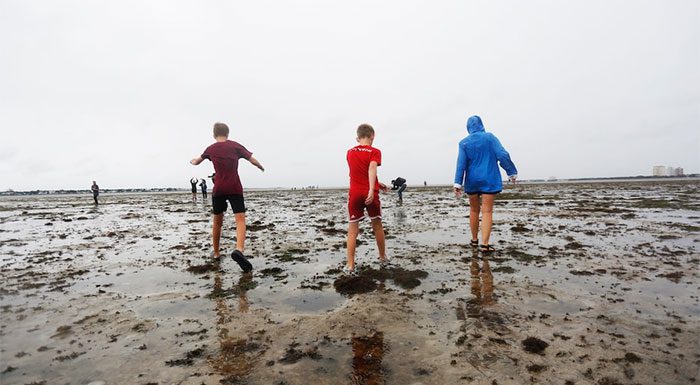Experts warn that people should not be curious and walk on the exposed seabed during low tide, as dangers can arise at any moment.
Strange Phenomenon Due to the Storm
Just a few hours before Hurricane Ian made landfall in Florida, the water along the coast was sucked away. The crashing waves and shallow beaches were quickly replaced by a barren seabed, revealing scattered white shells and seaweed.
Residents of the Tampa Bay area shared numerous videos showing the extensive beaches left dry after the water receded rapidly, a rare phenomenon before unusual storms. According to the Washington Post, this phenomenon is known as “reverse storm surge” – or water withdrawal phenomenon – which occurs when the winds from an offshore storm pull water away from the coast, causing the beach to dry out. This phenomenon is the opposite of high tide, when water near the coast rises to its highest level.
Storm-induced water withdrawals pose certain hazards, depending on their relative position to the eye of the storm.

The most dangerous part is that the water will quickly return, catching many people off guard.
As Hurricane Ian approached southwest Florida from the Gulf of Mexico, people in areas north of the storm’s eye saw the water being drawn away from the shore; similarly, areas south of the storm experienced the same. The most dangerous part is that the water will quickly return, catching many people off guard.
Hal Needham, a disaster and extreme weather scientist at GeoTrek, stated: “People may let their guard down when they see the water receding and think their risk is lower… that can create a false sense of security, and the water can rush back very quickly when the winds shift.”
When Needham walked along the beach on September 27, he observed waves crashing and foaming onto the seawall. However, when he strolled along the bay an hour earlier, the area that was once a harbor had turned into a sandbar.
“We can understand that nature is sending some sort of message. It makes you realize that this is not normal weather and a lot of strange things are happening. While many curious residents may want to stroll on the dry ocean floor, experts warn that this can be dangerous.”
“STOP NOW: Our advice is not to venture into the receding waters in Tampa Bay or Charlotte Harbor – the water WILL return with the storm and pose a life-threatening risk,” the Florida Emergency Management Agency stated in a tweet.
Similar to tsunami warning signs, experts caution that if you see the ocean water recede suddenly, stay as far away from the water as possible.
Unpredictable Dangers
Forecasters at the National Hurricane Center warned of a storm surge of up to 5 meters, which could threaten human lives.
Needham remarked: “When strong winds approach the shore and the high tide returns, the water will rise rapidly. The water can move so quickly that it can catch people off guard, which is why it is an unpredictable danger.”
In September 2017, when Hurricane Irma, a Category 4 storm, made landfall in Florida, many residents flocked to Tampa Bay to witness the bare beaches devoid of water. The tremendous water pull of Irma dragged coastal waters filled with debris toward the eye of the storm before releasing the water back in a surge when the winds shifted the storm’s eye.
Five years ago, tide gauges in Naples reported a water level drop of 1.8 meters from sunrise to 2 PM. Then, the water surged back up by 1.6 meters in just one hour, equivalent to an increase of about 2.5 centimeters per minute.
On the afternoon of September 28 (local time), Hurricane Ian made landfall in the state of Florida with maximum winds of around 241 km/h. Hurricane Ian was classified as a Category 4 storm on the 5-level U.S. hurricane warning scale.
This storm is one of the strongest to hit the U.S. in recent years. It is estimated that around 2.5 million residents in coastal Florida had to evacuate. Before making landfall in the U.S., Hurricane Ian swept through Cuba, forcing the government there to repair the power grid for over 11 million people. Reports indicate that Hurricane Ian resulted in at least 2 fatalities in western Cuba.


















































